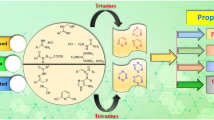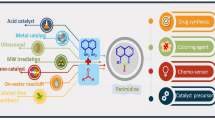Abstract
The results of many years of basic research that have led to the creation of a new generation of biologically active substances, atranes, are generalized in this article. Atranes are intracomplex compounds of triethanolamine, namely, metal atranes (primarily silatranes) and protatranes, which have substantially enriched important spheres of human activity, such as medicine and agriculture.
Similar content being viewed by others
References
M. G. Voronkov, G. I. Zelchan, and E. Ya. Lukevits, Silicon and Life (The Biochemistry, Pharmacology, and Toxicology of Silicon Compounds), 2nd ed. (Zinatne, Riga, 1978) [in Russian].
M. G. Voronkov and I. G. Kuznetsov, Silicon in Living Nature (Nauka, Novosibirsk, 1984) [in Russian].
E. D. Rokhov, The Silicon World (Khimiya, Moscow, 1990) [in Russian].
M. G. Voronkov, The Chemistry of Organosilicon Compounds in the Works of Russian and Soviet Scientists (Leningr. Gos. Univ., Leningrad, 1952) [in Russian].
M. G. Voronkov, G. I. Zelchan, and E. Lukevits, Silicium und Leben: Biochemie, Toxikologie und Pharmakologie der Verbindungen des Siliziums (Academie-Verlag, Berlin, 1975).
M. G. Voronkov and V. M. D’yakov, Silatranes (Nauka, Novosibirsk, 1978) [in Russian].
M. G. Voronkov, V. M. D’yakov, and S. V. Kirpichenko, “Silatranes,” J. Organomet. Chem. 233(1) (1982).
V. A. Pestunovich, S. V. Kirpichenko, and M. G. Voronkov, “Silatranes and Their Tricyclic Analogs,” in Chemistry of Organosilicon Compounds, Ed. by Z. Rappoport and Y. Apeloig (Willey&Sons, Chichester, 1998).
M. G. Voronkov and V. P. Baryshok, Silatranes in Medicine and Agriculture (Sib. Otd. Ross. Akad. Nauk, Novosibirsk, 2005) [in Russian].
Ya. Ya. Baltkais, M. G. Voronkov, and G. I. Zelchan, “Atranes: A Short Pharmacological Characteristic of Silatranes,” Latv. PSR Zinat. Akad. Vestis., No. 2, 102 (1964).
[Anonim] “Cage Si Compounds Are Biologically Active,” Chem. Eng. 43(51) (1965).
M. G. Voronkov, “Biological Activity of Silatranes,” Top. Curr. Chem. 84, 77 (1979).
M. G. Voronkov, G. A. Grigalinovich, and G. I. Zelchan, “The Inhibitory Effect of Some Silicon Compounds on the Growth of Malignant Tumor Cells,” Dokl. Akad. Nauk SSSR 200(4) (1971).
A. V. Bakulin, V. S. Oganov, L. A. Mansurova, et al., “Effect of 1-Chloromethylsilantrane on the Level of Minerals in Bone Calluses due to Fractures in the Tibial Long Bone,” Dokl. Akad. Nauk 344(6), 833 (1995).
I. V. Popov, A. E. Bolabovko, and M. G. Voronkov, “Effect of 1-Chloromethylsilantrane on Bone Reparative Regeneration in Experimentation,” Vestn. Voen.-Med. Akad, No. 1(13) (2005).
A. V. Bakulin, V. S. Oganov, L. A. Mansurova, et al., “Effect of 1-Chloromethylsilantrane on Bone Tissues under Hypodynamic Conditions,” Dokl. Akad. Nauk 339(6), 831 (1994).
V. P. Sergeev, S. V. Irlyanova, V. M. D’yakov, and M. G. Voronkov, “The Aid to Stimulate Hair Growth: USSR Inventor’s Certificate 1822769 (1976),” Byul. Izobr., No. 23 (1993).
G. I. Parfenov, Headlong Alopecia (Blagovest, Moscow, 2003) [in Russian].
M. G. Voronkov and V. P. Baryshok, “Antitumor Activity of Silatranes (A Review),” Khim. Pharm. Zh. 38(1), 5 (2004) [Pharm. Chem. J. 38 (1), 3 (2004)].
M. G. Voronkov and V. P. Baryshok, “Effect of Silatranes on Physiological Functions of Animals and Birds,” Ross. Khim. Zh. 49(3), 86 (2005).
V. I. Levakhin, V. I. Shmindt, F. I. Kalimullin, et al., “Effect of Antistress Preparations on Digestion and Metabolism in Ruminant Organisms: Improving Meat Quality by Antistress Preparations,” Vestn. Orenburg. Gos. Univ., No. 12, 88; 133 (2006).
“The List of Pesticides and Agricultural Chemicals Approved for Use in the Russian Federation, 1998,” Zashchita karantin rastenii,” No. 5, Suppl. (1998).
M. G. Voronkov, “Silatranes: Intra-Complex Heterocyclic Compounds of Pentacoordinated Silicon,” Pure Appl. Chem. 13(1), 35 (1966).
M. G. Voronkov and M. M. Rasulov, “Trecresan: Progenitor of a New Class of Adaptogens and Immunomodulators,” Khim. Farm. Zh. 41(1), 3 (2007) [Pharm. Chem. J. 41 (1), 1 (2007)].
M. G. Voronkov, O. P. Kolesnikova, M. M. Rasulov, and A. N. Mirskova, “Pharmacological Activity and Clinical Effects of Trecresan and Other Tris-(2-Hydroxyethyl)ammonium Salts of Arylheteroacetic Acids (A Review),” Khim. Farm. Zh. 41(5), 13 (2007) [Pharm. Chem. J. 41 (5), 244 (2007)].
M. G. Voronkov, A. I. Albanov, T. N. Aksamentova, et al., “Tris(2-hydroxyethyl)ammonium Salts: 2,8,9-Trihydroprotatranes,” Zh. Obshch. Khim. 79(11), 1817 (2009) [Russ. J. Gen. Chem. 79 (11), 2339 (2009)].
G. L. Starova, O. V. Frank-Kamenetskaya, V. S. Fundamenskii, et al., “Cresacin’s Crystalline and Molecular Structure: Tris(2-hydroxyethyl)ammonium-2-methylphenoxyacetate,” Dokl. Akad. Nauk SSSR 260(4) (1981).
O. P. Kolesnikova, A. N. Mirskova, S. N. Adamovich, et al., “Alkanolammonium Salts of o-Cresoxy- and p-Chlorocresoxyacetic Acids as Immunopoiesis Modulators and Cytostatics,” Dokl. Akad. Nauk 425(4), 556 (2009) [Dokl. Biol. Sci. 425, 107 (2009)].
Russia’s Pharmaceutical Register (Informkhim, Moscow, 1995) [in Russian].
Z. P. Sof’ina, M. G. Voronkov, V. M. D’yakov, et al., “Tris(2-hydroxyethyl)ammonium Salts of Some Synthetic Phytohormones and Their Antitumor Effect,” Khim. Farm. Zh., No. 4 (1978).
M. G. Voronkov, G. A. Sofronov, D. A. Starchenko, et al., “Protective Properties of Chlorocresacine against Adverse Impact of Electromagnetic Radiation,” Dokl. Akad. Nauk 428(1), 125 (2009) [Dokl. Biol. Sci. 428 (1), 398 (2009)].
V. Yu. Kassin, M. P. Nikolaev, L. D. Mironova, et al., “Experimental Research into the Effect of Some Biologically Active Substances on Fibroblast Growth,” Ross. Otolaryngol. 5(12) (2004).
M. G. Voronkov, A. P. Dyban, V. M. D’yakov, and N. L. Simbirtsev, “The Use of Trekrezan to Increase Fertility and Offspring Viability in Mammals,” Dokl. Akad. Nauk 364(5) (1999) [Dokl. Biol. Sci. 364, 23 (1999)].
Yu. G. Pavel, A. L. Karus, Yu. A. Kumar, et al., “The Use of Trecresanum to Stimulate Antibody Formation in Offspring of Experimental Animals during the Embryonic Period,” Dokl. Akad. Nauk 385(3), 419 (2002) [Dokl. Biol. Sci. 385, 323 (2002)].
V. N. Shmakov, Yu. M. Konstantinov, G. A. Kuznetsova, and M. G. Voronkov, “Effects of O-Hydrometalloatranes on the Growth of Cultured Plant Cells,” Dokl. Akad. Nauk 410(5), 716 (2006) [Dokl. Biol. Sci. 410, (1), 414 (2006)].
P. D. Shabanov, I. V. Zarubina, A. V. Bolekhan, et al., “Immunomodulator Trecresan,” Russ. Med. Zh., No. 12 (2005).
P. D. Shabanov, V. P. Ganapol’skii, I. V. Zarubina, et al., “Metabolic Activator Trecresan: Exploring Meteoadaptogenic and Immunomodulating Properties,” Neironauki 2(3) (2006).
D. A. Khankhodzhaeva and M. G. Voronkov, “Effect of Cresacin on the Growth, Development, and Productivity of Cotton Plants,” Dokl. Akad. Nauk 333(1) (1993).
M. G. Voronkov, G. Dolmaa, and Sh. Tserenpil, et al., “Stimulation of Barley Seed Germination by Micromolar Aqueous Solutions of Silatrane and Cresacin,” Dokl. Akad. Nauk 404(4), 562 (2005) [Dokl. Biol. Sci. 404, 367 (2005)].
L. E. Makarova, G. B. Borovskii, A. M. Bulatova, et al., “Effect of Triethanolamine Derivatives on Root Growth of Monocotyledonous and Dicotyledonous Plant Germs,” Agrokhim., No. 10 (2006).
E. B. Burlakova, “Effect of Extremely Low Doses,” Vestn. Ross. Akad. Nauk 64(5) (1994).
E. B. Burlakova, P. Ya. Boikov, R. I. Panina, and V. G. Kartsev, “Bimodal Effect of Picolinic Acid Derivatives on Wheat and Pea Germination Rate,” Izv. Akad. Nauk, Ser. Biol., No. 1 (1996).
E. B. Burlakova, A. A. Konradov, and E. L. Mal’tseva, “Effect of Ultra-Low Doses of Biologically Active Substances and Low-Intensity Physical Factors,” Khim. Fiz. 22(2), 21 (2003).
A. I. Konovalov, “The Physicochemical Secret of Extremely Low Doses,” Khim. Zhizn’ XXI V., No. 12 (2009).
Additional information
Original Russian Text © M.G. Voronkov, V.P. Baryshok, 2010, published in Vestnik Rossiiskoi Akademii Nauk, 2010, Vol. 80, No. 11, pp. 985–992.
Academician Mikhail Grigor’evich Voronkov is head of a laboratory at the Favorskii Institute of Chemistry, RAS Siberian Branch, and a laboratory at the Grebenshchikov Institute of Silicate Chemistry, RAS. Viktor Petrovich Baryshok, Dr. Sci. (Chem.), is a professor at Irkutsk State Technical University.
Rights and permissions
About this article
Cite this article
Voronkov, M.G., Baryshok, V.P. Atranes as a new generation of biologically active substances. Her. Russ. Acad. Sci. 80, 514–521 (2010). https://doi.org/10.1134/S1019331610060079
Published:
Issue Date:
DOI: https://doi.org/10.1134/S1019331610060079




